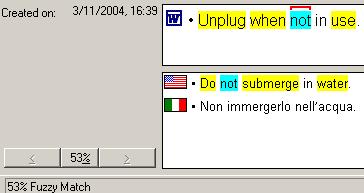Translation in Practice
Translation Process
A - SL writing
B - Translation
- Read SL Text
- Read to understand
- Identify unknown words/terms
- Read to understand
- Research terminology
- Online
- Reference works
- Decide on competing usage (Google as large collection of corpora)
- Online
- Write translation
- Question yourself
- Am I sure this is the best translation?
- Does this sound right and familiar only because I always translated it like that?
- Different techniques
- Use CAT tools
- Write directly in word processor
- Overwrite original
- Write first draft with optional wording, to be self-edited later
- Example:
- Write first/rough draft using optional/preliminary/candidate terms/words...
- Write first/rough draft using optional/preliminary/candidate terms/words...
- Am I sure this is the best translation?
- Self-edit translation
- Read your translation
- Does it read like a similar document written by a native speaker of the TL would read?
If it does not make sense, there is a problem (and "but the original did not make sense, either" or "but I used the same words as the original" are not good excuses)
- If possible, set it aside after the first draft, to look at it with fresh eyes
- Send translation to editor
- Does it read like a similar document written by a native speaker of the TL would read?
C - Quality Control steps
- Editing
- Review translation against SL text
- Errors of meaning
- Errors of form
- Errors of compliance
- Preferential changes
- Track changes
- Change translation directly
- Errors of meaning
- Proofing
- Review only the TL text (checking the SL
only if necessary)
- Review only the TL text (checking the SL
- Other quality control steps (These take place all during the process, from terminology work onwards)
- Verification that translation is complete (all files translated)
- Other QC steps
- Verification that translation is complete (all files translated)
D - QA
- Techniques used in order to assess the effectiveness of QC work
- Translation quality measurement
Technology, tools, reference materials and publications
Hardware
Computer: PC or Mac?
- PC environment much more widespread
- Greater availability of CAT tools
- Easier to meet customers' requirements
- Cheaper computers
- Greater availability of CAT tools
- Mac preferable when working with graphic designers
Desktop or laptop?
- Laptop permits to work anywhere
- Desktops
- More powerful
- Cheaper
- More robust
- More powerful
Peripherals
- Scanner (Necessary if much work is received as hardcopy)
- Printer (Desktop lasers are the most economical choice)
- External hard disk (For removable back-ups)
- UPS (Uninterruptible power supply)
Fast Internet connection
- Essential when working with large files
- Useful when surfing the web for research purposes
Software
- Normal software tools (Office software)
- MS Office
- Specialized search techniques using wildcards (Regular Expressions)
- Using Excel to create "ad hoc" translation tools for the translation of software strings (especially when there are size limitations and such)
- Using Excel to create translation memories from text glossaries
- Specialized search techniques using wildcards (Regular Expressions)
- Open Office
- Star Office
- MS Office
- CAT (Computer-Aided Translation) tools
- SDL
- Trados
- Currently the market leader
- Buggy
- No free "lite" version
- SDLX
- "Lite" version available (Works only with projects created by customer)
- Currently the market leader
- Déjà Vu
- Omega T
- Freeware
- Freeware
- Wordfast
- Mostly compatible with Trados
- Cheaper than most other CAT tools
- Works with the Mac
- Mostly compatible with Trados
- Transit
- Other translation memory tools
- SDL
- Terminology management tools
- Additional software tools
- Localization tools
- Catalyst
- Multilizer
- Other localization tools
- Catalyst
- Specialized search tools
- Adobe Acrobat
- Professional (Permits editing, annotating, etc.)
- Reader (Freeware)
- Professional (Permits editing, annotating, etc.)
- Text editors
- Windows' Note Pad is free
- TextPad
- Ultra Edit
- Windows' Note Pad is free
- DTP programs
- Framemaker (Text-intensive documents)
- Quark
- InDesign
- Framemaker (Text-intensive documents)
- HTML editors
- Front Page
- DreamWeaver
- Etc.
- Front Page
- Graphic editing tools
- Photoshop
- Photoshop Elements (Cheaper alternative, permits editing text in Photoshop files)
- Illustrator
- Photoshop
- OCR (Optical Character Recognition) tools, such as Omnipage (Useful when one receives documents to translate in hardcopy or pdf, and needs to transform them into editable files)
- Word counting software
- Translation project management tools (e.g., Translation Office 3000
- Clipboard utilities (e.g., ClipMate)
- Screen capture tools (e.g., Gadwin PrintScreen
- Localization tools
- Google and other online search aids
- MT (Machine Translation)
Reference materials
- Jost Zetzche's Translator's Tool Box
- Dictionaries
- Printed dictionaries
- Dictionaries on CD-ROM
- Differences v. paper dictionaries
- More powerful searches
- WordWeb Pro
- Differences v. paper dictionaries
- Online dictionaries
- Printed dictionaries
- Glossaries
- Do-it-yourself (See above, "Software for terminology management")
- Online glossaries (WARNING: separate the wheat from the chaff!)
- WikiWords
- Do-it-yourself (See above, "Software for terminology management")
- Other reference materials
Assignments for next class
Assignment: read chapters 6 and 7 in "Becoming a Translator", and Chapter 4 of "How To Succeed As A Freelance Translator"Notes from the previous lessons in this course:
Foundations of Translation - Course Description
Foundations of Translation - Lesson 1: Difference between translation and interpreting
Foundations of Translation - Lesson 2: Jobs for translators
Foundations of Translation - Lesson 3: Characteristics of a good translator


